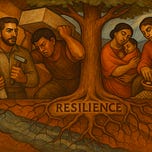The End of Stability, the Beginning of Strength
We are living through a century of cascading uncertainty.
This week we watched as geopolitical standoffs and protectionist policies erased decades of stability overnight.
Systems that once felt solid—healthcare, education, governance—are fraying in real time.
Trump’s recent actions—aggressive tariffs, economic nationalism, and punitive trade measures—did not just reshape markets; they amplified systemic fragility and accelerated the shift away from stability-based models of strength, creating a cascade of retaliation that proved the old fortress model is obsolete.
Strength is not individualism, control, or how hard you hit. It’s how deeply you’re rooted while still growing.
The new model in’t a fortress—it’s a regenerative ecosystem.
From the Crash to the Core: What the “Traitorous Eight” Can Teach Us Now
This is a story about decoupling from authoritarian control, strength through strategic risk, moral agency, and planting a seedbed for a new era.
In 1957, in what would become the heart of Silicon Valley, eight engineers faced a decision that would shape the future.
They worked for William Shockley—Nobel winner, silicon transistor pioneer, and an increasingly paranoid and tyrannical racist (Reid, 2001). Shockley was the kind of leader who liked eugenics, and used lie detectors at work to seek out disobedience and disloyalty.
The environment was toxic, but Shockley? Untouchable.
Despite the prestige of their positions, the eight engineers made a bold—and disobedient—move.
They quit.
This group, the “Traitorous Eight,” founded Fairchild Semiconductor. It wasn’t just a new company. It was the rootstock from which Intel, AMD, NVIDIA, and hundreds of “Fairchildren” would grow. They endured betrayal, uncertainty, and criticism. Yet their courage transformed not only electronics but the global economy.
This isn’t a story of circuits. It’s a story of strength.
Not just technical expertise, but emotional endurance, mental clarity, physical stamina through grueling cycles of invention, and financial risk-taking that reshaped history.
This is a multidimensional strength—what we cultivate in Adaptive Resilience.
All that cascades into a larger system that starts with what we can control today.
Let’s take a look.
The Foundations of Strength In Four Dimensions
Strength isn’t about how much weight you can lift, or how much weight you carry. It’s how well you adapt, recover, and expand.
In Adaptive Resilience, strength lives in four domains:
Physical: Your body’s foundation for action.
Mental: Flexibility and sustained cognition.
Emotional: Integration and regulation of feeling.
Financial: Optionality, security, and time.
Each domain reinforces the others. Like a table with four legs, weakness in one can tip the whole. But when reinforced together, they form a system of regenerative power.
The four dimensions are connected:
Money stress? Your mental bandwidth shrinks.
Poor sleep? Emotional regulation crashes.
Emotional exhaustion? Physical performance drops.
Cognitive burnout? You make bad financial decisions.
But strength cascades too: A morning walk clears the mind, softens anxiety, and helps you avoid costly mistakes.
This is why strength must be integrated, not isolated.
In my own resilience journey, I’ve recovered from broken bones and chronic illness. I’ve felt this interconnection when chronic fatigue cascaded into clouded decision-making and an impacted quality of life. Each challenge took a specific path to recovery, and always started with the smallest of steps.
In my story the steps are literal. I went from a team of doctors warning me that I may not walk, to re-learning to walk, and now running 7 or 8 miles daily along the beach where I live.
The Adaptive Resilience framework emerged from research and experience. It’s a collection of knowledge, reframed, put to the test, and set in motion.
Physical Strength Is The Engine of Adaptation
When your body’s depleted, your emotional bandwidth shrinks and your cognitive clarity dims.
Your mental and emotional capacities rest on a biological platform.
Energetic capacity: If you don’t have energy, you don’t have agency.
Functional robustness: A strong body absorbs shocks.
Efficient recovery: Resilience isn’t just how hard you go, but how fast you regenerate.
This isn’t just poetic—it’s biological. In the field of psychoneuroimmunology, researchers have shown how physical strain and poor sleep impair immune function, dampen mood, and distort perception (Ader, Felten, & Cohen, 1991; McEwen, 1998).
Mental Strength: Flexibility Over Rigidity
In the psychological sciences, cognitive reappraisal—the ability to rethink a situation—is one of the most effective strategies for resilience. It rewires the brain’s response to adversity, increasing both mental clarity and emotional stability (Gross, 2014).
Attention control: Focus is the gateway to everything else.
Cognitive endurance: Stamina outlasts flashes of brilliance.
Reappraisal agility: Mentally strong people don’t erase pain—they reinterpret it.
“Between stimulus and response there is a space. In that space is our power to choose our response. In our response lies our growth and our freedom.” (Frankl, 1946)
Victor Frankl’s insight from 1946 captures the essence of mental strength: the ability to create space between experience and reaction.
Emotional Strength: The Compass Within
Emotional stability: The ability to return to center—without numbing.
Resilience: You bounce back not by avoiding pain, but by metabolizing it.
Feeling integration: Emotions don’t hijack you—they guide you.
According to Daniel Siegel (2010), integration—not control—is the foundation of emotional health (Siegel, 2010). To be strong emotionally is not to suppress or override your feelings. It is to feel fully without being flooded. He said, “Integration is the linking of differentiated parts into a functional whole.”
Your emotions are not enemies of strength. They are signals. The stronger you are, the more you can listen to them clearly—and act from wisdom, not reactivity.
Financial Strength: Optionality is Resilience
Resource sufficiency: Meet your needs without crisis.
Strategic optionality: The freedom to pivot when the winds shift.
Reduced reactivity: Scarcity narrows your bandwidth. Stability expands it.
In their work Scarcity, Mullainathan and Shafir (2013) demonstrate how financial strain consumes executive function, making people more impulsive and less creative. Stability is more than security—it is cognitive space (Mullainathan & Shafir, 2013).
"Under scarcity, because our minds are heavily engaged with the present crisis, we have less mind for the rest."
The antidote? Strategic slack. Build a buffer. Widen the window. Give yourself time to make wise moves.
Three Principles of Strength Creation
Active strength is not what you stockpile. It’s what flows and circulates.
Passive strength hoards resources, measures “self against self,” and braces for imagined emergencies.
Yet active strength is relational, builds systems that lift others, and circulates value.
Prioritize Foundations Over Summits. Don’t chase feats if your foundation is cracked. Deadlifting once a month won’t mend disrupted sleep or chronic fatigue. True strength thrives on steady rhythms, not spikes of intensity. Build a wide, stable baseline across all domains.
Design for Regeneration, Not Just Consumption You’re not a machine. You’re a biome—you are built to regenerate. You don’t just use energy—you transform it. Real growth isn’t measured by what you burn but how gracefully you metabolize life’s challenges into enduring strength (McEwen, 1998).
Integrate, Don’t Isolate The strongest practices weave seamlessly across life’s dimensions. A single hike can nourish your body, sharpen your mind, and soothe your emotions. A purposeful project that creates wealth—even something small—can bolster confidence, deepen connections, and cultivate financial resilience.
Strength multiplies when practices overlap and support each other.
The 4×4 Strength Audit
The 4×4 Strength Audit is how we check in, get real, and get stronger—on purpose.
This shows where you’re strong—and where things could break under pressure.
It’s four steps, and four tasks.
Step 1: Self-Rate Each Domain (1–10)
Physical: Energy, sleep quality, breath awareness, movement freedom
Mental: Focus clarity, memory agility, insight depth, adaptability speed
Emotional: Regulation steadiness, responsiveness ease, emotional depth
Financial: Resource flexibility, sufficiency, abundance circulation
Score each one:
1 = Barely sustaining
10 = Rooted and thriving
This self-assessment activates your brain’s salience network, clarifying priorities and revealing vulnerability under stress (Menon, 2011).
Step 2: One Strength + One Struggle
Clarity begins by acknowledging what’s working—and what needs work.
An example in the emotional domain:
Strength: “I handle crises calmly.”
Struggle: “I bury smaller frustrations until they erupt.”
Naming struggles returns power from unconscious habit to intentional choice.
Step 3: Choose One Catalyst—Activating Two Domains at Once
This is a force multiplier. Combine two domains to amplify resilience.
💥 Catalyst Options:
Jogging + Reframing (Physical × Mental)
Jog briskly for 20 minutes. Use this time to reframe a recent frustration into a lesson for yourself. Movement stimulates clarity; reframing trains cognitive resilience. Movement wakes up your body, and reframing trains your brain to handle stress better.
Physical Exercise + Emotional Reflection (Physical × Emotional)
Perform a challenging physical exercise. It doesn’t have to be complicated. Immediately afterward, pause and name your feelings without judgment. Strengthen your body and emotional honesty simultaneously.Financial Review + Bold Idea (Financial × Mental)
Assess your financial flow for six months ahead. Identify one bold step to expand your possibilities—no matter how far-fetched. This changes your stories about money from anxiety to action, not fear.
Step 4: Commit to a Daily Strength Ritual for Your Weakest Area
Start small—but strong.
Examples:
Physical: Five deep breaths and ten single-leg squats each morning before devices or tasks. This grounds your focus.
Mental: Journal three daily occurrences and proactively reframe each for clarity. This trains your brain to think clearly, even when stressed.
Emotional: Record a voice memo daily expressing your genuine feelings, no filter. Expressing yourself helps you regulate when you need to.
Financial: Spend intentionally—$10 or 10 minutes—to support someone else’s growth. Giving builds freedom and stops fear from ruling your money.
Radical Reminder: Exercise Is Non-Negotiable
No movement, no resilience.
From mitochondria to mood, movement is the only intervention that touches every system.
Boosts BDNF—think “fertilizer for your brain”—and prefrontal function. (Mattson, 2012)
Improves emotional regulation via vagus nerve stimulation. (Nivethitha et al., 2016)
Enhances executive function and decision quality under scarcity. (Shiv et al., 2005)
No pill. No journal. No visualization.
Only movement has that range. Make strength a practice, not a finish line.
Tying it Together
You are not here to brace for impact. You are here to regenerate and flourish.
Build the kind of strength that doesn’t just survive disruption—it roots, it flows, and it circulates. Adaptive. Resilient. Alive.
Up Next: Flow
Next week, we explore how Flow emerges—not from hustle or stress—but from well-aligned strength. Without strength, flow collapses into chaos. With too much rigidity, it fossilizes. True flow, like a river, needs channel and movement. We’ll learn to create both.
Thank you
I’m Kevin Dickerson. Thanks for listening. Thanks for reading. We’ll see you next week.
Don’t miss out on next week’s exploration of Flow—subscribe now.
Your Turn
Which strength domain are you focusing on right now? Share your integration practices in the comments. Share with someone who needs this. Your insights help our community grow stronger together.
References
Ader, R., Felten, D. L., & Cohen, N. (1991). Psychoneuroimmunology (2nd ed.). Academic Press.
Allen, J. (1903). As a man thinketh. Thomas Y. Crowell & Co.
Deaton, A. (2013). The great escape: Health, wealth, and the origins of inequality. Princeton University Press.
Dweck, C. S. (2006). Mindset: The new psychology of success. Random House.
Frankl, V. E. (1946). Man’s search for meaning. Beacon Press.
Gross, J. J. (2014). Emotion regulation: Conceptual and empirical foundations. In J. J. Gross (Ed.), Handbook of emotion regulation (2nd ed., pp. 3–20). Guilford Press.
Mattson, M. P. (2012). Energy intake and exercise as determinants of brain health and vulnerability to injury and disease. Cell Metabolism, 16(6), 706–722. https://doi.org/10.1016/j.cmet.2012.10.004
McEwen, B. S. (1998). Protective and damaging effects of stress mediators. The New England Journal of Medicine, 338(3), 171–179. https://doi.org/10.1056/NEJM199801153380307
Menon, V. (2011). Large-scale brain networks and psychopathology: A unifying triple network model. Trends in Cognitive Sciences, 15(10), 483–506. https://doi.org/10.1016/j.tics.2011.08.003
Mullainathan, S., & Shafir, E. (2013). Scarcity: Why having too little means so much. Times Books.
Nivethitha, L., Mooventhan, A., & Manjunath, N. K. (2016). Effects of yogic breathing techniques on heart rate variability and baroreflex sensitivity in patients with essential hypertension: A randomized controlled trial. Integrative Medicine Research, 5(3), 170–175. https://doi.org/10.1016/j.imr.2016.06.007
Reid, T. R. (2001). The chip: How two Americans invented the microchip and launched a revolution. Random House.
Shiv, B., Fedorikhin, A., & Nowlis, S. M. (2005). Heart and mind in conflict: The interplay of affect and cognition in consumer decision making. Journal of Consumer Research, 26(3), 278–292. https://doi.org/10.1086/209563
Siegel, D. J. (2010). The mindful therapist: A clinician’s guide to mindsight and neural integration. W. W. Norton & Company.







